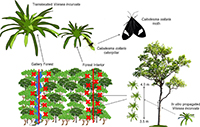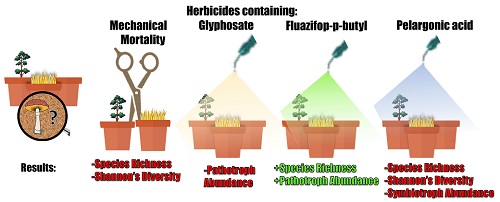Vriesea incurvata is an epiphytic tank bromeliad endemic to the Atlantic Forest in Brazil, a biodiversity hotspot with about 90% of its domain altered. We evaluate the influence of herbivory on the survival and development of micropropagated V. incurvata translocated into two micro-environments: (1) gallery forest; and (2) forest interior. Herbivory by Calodesma collaris, together with abiotic factors, exerts differential pressure on translocated populations, with a lesser negative impact in the gallery forest. Greater spacing between plants attached to the phorophyte, in trees scattered throughout the forest fragment, might minimise the impact of caterpillars on the translocated population. Image by Márcio Hisayuki Sasamori and Delio Endres Júnior.

Australian Journal of Botany
Volume 73 Number 4 2025
Cerberiopsis candelabra, a species endemic to New Caledonia, is one of the world’s rare monocarpic trees. This canopy tree flowers once and subsequently dies. The survival and growth rate of seedlings are significant preconditions for the maintaintenance of this strategy in tropical forests. We found that this species has a high survival rate to maintain high seedling density and we show that seedling growth is continuous but strongly responsive to climate seasonality. Image by authors.
The study investigated the history of alpine and subalpine plants in south-central Tasmania over the past 15,000 years. By analysing fossil plant remains from Lake Dobson in Mount Field National Park researchers have uncovered evidence suggesting that the modern configuration of the vegetation near the treeline was reached c. 6000 years ago. These findings emphasise the individualistic plant responses and strategies during a time of significant environmental transformation, allowing us to understand how fast plant species can respond to such changes. Photographs by G. A. Astorga.
Invasive species are mostly controlled by herbicides that may result in non-target effects on essential soil fungi. Diverse fungal communities were obtained from a native tree and invasive grass species for herbicide testing. Herbicides containing pelargonic acid decreased species richness and Shannon diversity and fluazifop-p-butyl herbicides increased the relative abundance of pathogenic fungi. Photograph by Aaron Brace.
BT24083 Abstract | BT24083 Full Text | BT24083PDF (2.3 MB) | BT24083Supplementary Material (922 KB) Open Access Article








